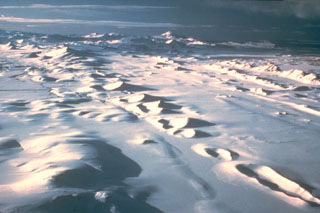Report on Bardarbunga (Iceland) — 21 January-27 January 2015
Smithsonian Institution / US Geological Survey
Weekly Volcanic Activity Report, 21 January-27 January 2015
Managing Editor: Sally Sennert.
Please cite this report as:
Global Volcanism Program, 2015. Report on Bardarbunga (Iceland) (Sennert, S, ed.). Weekly Volcanic Activity Report, 21 January-27 January 2015. Smithsonian Institution and US Geological Survey.
Bardarbunga
Iceland
64.633°N, 17.516°W; summit elev. 2000 m
All times are local (unless otherwise noted)
During 21-27 January, IMO maintained Aviation Colour Code Orange due to continued activity at Bárdarbunga’s Holuhraun eruptive fissure. The lava field expanded along the N and NE margins. Seismicity remained strong and local air pollution from gas emissions persisted. Very high values of sulfur dioxide, about 84,000 µg/m3, were recorded at the eruption site on 21 January; this value was the highest recorded at ground level since the eruption started. Total subsidence of the Bárdarbunga surface since mid-August was 61 m, and the volume of erupted lava was an estimated 1.4 cubic kilometers. The lava field covered 84.7 square kilometers on 22 January. A report issued on 27 January stated that the average rate of lava emission during the previous three weeks was just less than 100 cubic meters per second, therefore the intensity of the eruption was slowly decreasing.
Geological Summary. The large central volcano of Bárðarbunga lies beneath the NW part of the Vatnajökull icecap, NW of Grímsvötn volcano, and contains a subglacial 700-m-deep caldera. Related fissure systems include the Veidivötn and Trollagigar fissures, which extend about 100 km SW to near Torfajökull volcano and 50 km NE to near Askja volcano, respectively. Voluminous fissure eruptions, including one at Thjorsarhraun, which produced the largest known Holocene lava flow on Earth with a volume of more than 21 km3, have occurred throughout the Holocene into historical time from the Veidivötn fissure system. The last major eruption of Veidivötn, in 1477, also produced a large tephra deposit. The subglacial Loki-Fögrufjöll volcanic system to the SW is also part of the Bárðarbunga volcanic system and contains two subglacial ridges extending from the largely subglacial Hamarinn central volcano; the Loki ridge trends to the NE and the Fögrufjöll ridge to the SW. Jökulhlaups (glacier-outburst floods) from eruptions at Bárðarbunga potentially affect drainages in all directions.

